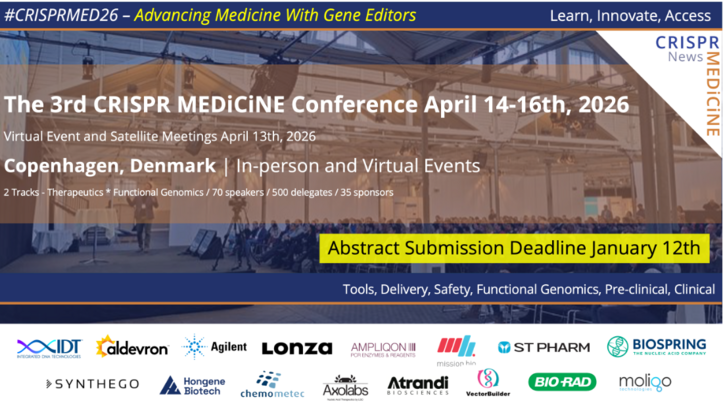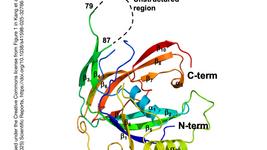CMN Weekly (2 August 2024) - Your Weekly CRISPR Medicine News
By: Karen O'Hanlon Cohrt - Aug. 2, 2024
Top pick
- What does CRISPR therapy mean to a patient? We are thrilled to have announced this week that Jimi Olaghere, a CASGEVY recipient who participated in CRISPR Therapeutics' and Vertex Pharmaceuticals' groundbreaking clinical trial, will share his story at CRISPRMED25. Read more about that here.
Research
- Researchers in China develop a magnetothermal-induced CRISPR-Cas9 gene-editing system for the targeted knockout of HSP70 and BCL2 genes as novel approach to ablate cancer cells without harming healthy nearby cells. The magnetothermal nanoparticulate platform allows plasmid DNA to be loaded, and under the induction of a controllable alternating magnetic field, the mild magnetothermal effect (42℃) not only triggers dual-genome editing to disrupt the apoptosis resistance mechanism of tumour cells but also sensitises tumour cells to apoptosis through the heat effect itself, achieving a synergistic therapeutic effect. Their findings were published in the Journal of Nanobiotechnology earlier this week.
- Glaucoma is an incurable condition that affects approximately 80 million individuals worldwide. The main risk factor for glaucoma development is elevated intraocular pressure, which is determined by the balance between the secretion and outflow of aqueous humor. In an article published in Nature Communications earlier this week, scientists in the UK and China show that the RNA interference tool CasRx can reduce the expression of the aqueous humor circulation related genes Rock1 and Rock2, as well as aquaporin 1 and the β2 adrenergic receptor in female mice. This strategy significantly reduced intraocular pressure in female mice, provided protection to the retina ganglion cells, and slowed disease progression.
- Recognising the limitation of deaminase-derived DNA base editors that cannot directly edit thymine and guanine, scientists in China report base editing of both cytidine and thymine by leveraging the translesion DNA synthesis pathway through the engineering of uracil-DNA glycosylase (UNG). In an article published in Nature Communications this week, they show that when fused with the nickase Cas9, an engineered Deinococcus radiodurans UNG mutant (termed DrUNG) facilitates efficient thymine base editing at endogenous sites, achieving editing efficiencies up to 55% without enrichment and exhibiting minimal cellular toxicity. The team also demonstrates that the novel base editor could restore IDUA enzyme activity in cells derived from patients with Hurler syndrome.
- In an article published in Nucleic Acids Research, researchers in Israel introduce CRISPECTOR2.0, which is an extended version of their previously published software tool CRISPECTOR, with an allele-specific editing activity quantification option. According to the authors, CRISPECTOR2.0 enables reference-free, allele-aware, precise quantification of on- and off-target activity, by using de novo sample-specific single nucleotide variant (SNV) detection and statistical-based allele-calling algorithms. They show that the new tool is efficient in quantifying allele-specific editing activity in diverse sample types containing multiple alleles, and they highlight the importance of measuring allele-specific editing outcomes in the context of safe, personalised genome editing.
- Scientists in Israel have developed DeepCRISTL, a deep-learning model to predict the editing efficiency in a specific cellular context. The new tool uses high-throughput datasets to learn general patterns of gRNA editing efficiency, and then fine-tunes the model on functional or endogenous data to fit a specific cellular context. The team tested two state-of-the-art models (DeepHF and CRISPRon) trained on high-throughput datasets for editing efficiency prediction combined with various transfer-learning approaches, and found that the combination of CRISPRon and fine-tuning all model weights was the overall best performer. Their findings were published in Bioinformatics earlier this week.
- A team at the University of Philadelphia and Children's Hospital of Philadelphia have developed an in utero delivery strategy using targeted ionizable lipid nanoparticles (LNPs), which facilitates in vivo gene editing of haematopoietic stem cells (HSCs). They show that optimised and targeted LNPs enhanced gene editing at a proof-of-concept locus in foetal HSCs after a single in utero intravenous injection. They propose that by targeting HSCs in vivo during foetal development, the Systematically optimised Targeted Editing Machinery (STEM) LNPs may provide a translatable strategy to treat monogenic blood diseases before birth. Their findings were published in PNAS.
- Loss-of-function mutations in splicing factor RNA-binding motif protein 10 (RBM10) are found frequently in lung adenocarcinoma (LUAD). These generally correlate with increased tumorigenesis which limits the efficacy of current LUAD-targeted therapies, yet therapeutic strategies leveraging RBM10 deficiency remain unexplored. To explore the potential of RBM10 as a therapeutic target in LUAD, a team in Israel conducted a CRISPR-Cas9 synthetic lethality screen which identified ~60 RBM10 SL genes, including WEE1 kinase. They found that WEE1 inhibition sensitises RBM10-deficient LUAD cells in vitro and in vivo, and further characterisation suggests a role for RBM10 in fine-tuning DNA replication. The findings, published in Nature Communications, suggest potential for targeting RBM10-deficient tumours.
Industry
- Intellia Therapeutics announced this week that the UK’s Medicine and Healthcare products Regulatory Agency has cleared its clinical trial application for NTLA-3001, an in vivo CRISPR-based therapeutic candidate in development for the treatment of alpha-1 antitrypsin deficiency. Read more about that in our latest clinical trial update here.
- Cellectis announced yesterday that the FDA has granted Orphan Drug Designation to CLLS52 (alemtuzumab), an Investigational Medicinal Product used as part of the lymphodepletion regimen associated with Cellectis' therapeutic candidate UCART22, evaluated in the BALLI-01 clinical trial in relapsed/refractory B-cell acute lymphoblastic leukaemia. See the official press release for further details.
- AIRNA, a biotech company pioneering RNA-editing therapeutics for rare and common diseases, announced this week that it has closed an oversubscribed $60 million financing round, which brings the company's total Series A funding to $90 million. According to a press release, the proceeds from the Series A financing, which was led by Forbion, will be used to advance AIRNA’s lead product candidate for alpha-1 antitrypsin deficiency into clinical trials and further develop AIRNA’s broad pipeline. See the official press release for further details.
- Precision Biosciences reported its second quarter 2024 financial results and business update in a press release published yesterday. Among the updates were that the company's wholly owned programmes PBGENE-HBV for Chronic Hepatitis B virus and PBGENE-PMM for m.3243 mitochondrial disease are on track for clinical trial submissions in the US and EU in 2024 and 2025, respectively.
- Vertex Pharmaceuticals reported second quarter 2024 financial results yesterday. The company disclosed that it has sufficient capital to realise Phase 1 clinical data for multiple in vivo gene editing programmes, and an expected cash runway into the second half of 2026. The company also reported that it has regained control of three advanced pre-clinical programmes for development internally or with partners, including a novel gene-editing approach for Duchenne muscular dystrophy. See the official press release for further details.
Detection
- Scientists in China present a nucleic acid detection strategy that combines an exonuclease III cascaded with CRISPR/Cas12a (Exo-III/Cas12a) amplification strategy coupled to a smartphone-based portable fluorescence detector (SPFD). With the goal to repurpose the commercial alpha-fetoprotein (AFP) strip for the ultrasensitive and hand-held detection of nucleic acid samples for diagnostics, the team reports universe applicability of the proposed platform toward miRNA-155, 16S rRNA of Staphylococcus aureus, and ORF1a/b RNA of Covid-19 pseudovirus with low limits of detection. The findings were published this week in Analytical Chemistry.
- A team in Singapore reports a one-pot, proximity-based isothermal immunoassay integrating CRISPR-Cas12a for homogeneous protein target detection. In their setup, probes consisting of different binders conjugated with oligonucleotides undergo two-way extension upon binding to protein targets, leading to downstream DNA amplification by a pair of nicking enzymes and polymerases to generate target sequences for Cas12a signal generation. Using the streptavidin-biotin model, they showed that all three elements of protein detection (target protein binding, DNA amplification, and Cas12a signal generation) could coexist in one pot and proceed isothermally in a single buffer system in low reaction volume of 10 μL. They validated their workflow using four different protein targets, with limits of detection ranging from fM to pM. The findings were published in ACS Sensors.
Reviews
- Gene editing in liver diseases. In this review article, scientists in Spain and United States summarise the pre-clinical data obtained on gene editing in animal models of inherited liver diseases and the clinical data obtained thus far, emphasising both the therapeutic efficacy and potential limitations of these medical interventions.
- Exploring non-viral methods for the delivery of CRISPR-Cas ribonucleoprotein to hematopoietic stem cells. This is a comprehensive review of non-viral methods to deliver CRISPR reagents to haematopoietic stem cells (HSCs), including microfluidic-based techniques, filtroporation, nanoparticles, and cell-penetrating peptides. The authors also discuss recent research advances concerning delivery approaches of RNP complexes to HSCs.
- Epigenome editing technologies for discovery and medicine. This review provides an overview of epigenome-editing technology and its context among other genome-editing tools, includes a useful list of commonly used epigenome activators and repressors, and summarises applications in functional genomics, cell engineering, and gene/cell therapy. The authors also discuss challenges as well as open opportunities remaining in the field.
News from CRISPR Medicine News
- On Wednesday, we published an article about Intellia's recent clinical trial clearance by the UK’s Medicine and Healthcare products Regulatory Agency to initiate a trial of NTLA-3001. Read that update here.
To get more CRISPR Medicine News delivered to your inbox, sign up to the free weekly CMN Newsletter here.
Tags
ArticleMissing linksNewsCMN WeeklyAIRNACellectis S.A.Intellia Therapeutics, Inc.Precision BioSciences, Inc.Vertex Pharmaceuticals, Inc.
CLINICAL TRIALS
IND Enabling
Phase I
Phase II
Phase III
Gastric Cancer and Colorectal Cancer, CRC, (NCT07166263)
Sponsors:
Base Therapeutics (Shanghai) Co., Ltd.
Sponsors:
Base Therapeutics (Shanghai) Co., Ltd.
IND Enabling
Phase I
Phase II
Phase III
Relapsed or Refractory Acute Myeloid Leukemia, AML, (NCT06541444)
Sponsors:
Base Therapeutics (Shanghai) Co., Ltd.
Sponsors:
Base Therapeutics (Shanghai) Co., Ltd.
IND Enabling
Phase I
Phase II
Phase III







